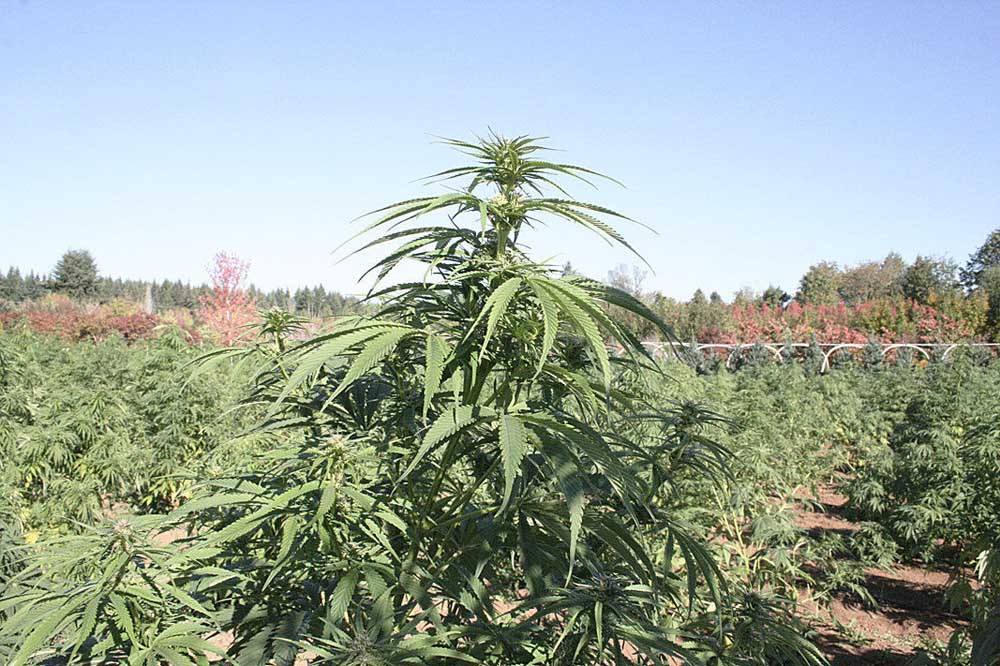Oregon hemp enforcement uncovers ‘presumptive marijuana’
Published 7:45 am Wednesday, October 6, 2021

- Hemp grows in an Oregon field.
About 18% of Southern Oregon hemp farms recently tested by state farm regulators either tested positive for “presumptive marijuana” or exceeded the crop’s THC limit.
The Oregon Department of Agriculture conducted the recent testing campaign as part of a broader focus on enforcing hemp regulations.
Operation Table Rock — which refers to a geological feature near Medford — was also intended to respond to local concerns about black-market marijuana growers using hemp for subterfuge.
Law and code enforcement officers in the region told ODA that roughly 75% of the hemp farms would actually be growing marijuana, said Mike Odenthal, the agency’s hemp manager. Marijuana is a related type of cannabis that has psychoactive levels of the compound THC.
“We have more legitimate hemp being grown than we initially thought we might have,” he said. “However, we still have a significant problem.”
That nearly 1 in 5 hemp farms tested by the department contained excessive levels of THC is troublesome news for the state’s hemp industry, which is already contending with economic and regulatory problems.
“We were shocked. We were disappointed there was not more compliance with the program,” said Courtney Moran, president of the Oregon Industrial Hemp Farmers Association.
However, the enforcement push has also caused some hemp farmers to feel the crop’s been targeted for punitive treatment by regulators.
“This is absolutely overreach by the government,” said Mark Taylor, founder of the Southern Oregon Hemp Cooperative.
The overall farm industry doesn’t seem concerned with the “draconian” measures aimed at the hemp sector, he said. “Nobody is standing up because they don’t believe it affects them.”
Meanwhile, community members concerned about illegal marijuana production aren’t convinced the operation’s statistics reflect on-the-ground reality in Southern Oregon.
“They were only testing the registered plantings,” said Gordon Lyford, an agricultural engineer and water rights examiner in the region.
Most of the purported hemp operations in the area that grow marijuana don’t bother obtaining a license from ODA, Lyford said.
“They put up a sign — ‘registered hemp grow’ — and it’s all phony,” he said.
The ODA is still processing the data gathered under the operation while deciding on enforcement actions, but following is the most recent information from 292 sites tested:
• Hemp was found to comply with the crop’s 0.3% THC limit at 85 sites, or 29% of the total.
• The crop wasn’t found to be growing at 68 of the sites, or 23% of the total, even though they’d been registered for hemp.
• Another 36 farms, or 12% of the total, were found to be growing “presumptive marijuana,” which means that half the plant samples contained more than 5% THC or that their average THC level was above 5%.
• Cannabis above the 0.3% THC hemp limit but below the 5% threshold for “presumptive marijuana” was found at 18 of the sites, or 6% of the total.
• The remaining 85 sites had immature plants and are being re-tested.
The ODA conducted the operation with help from the Oregon Liquor and Cannabis Commission and local law enforcement agencies.
The findings validate the worries of community members who worried that hemp’s being used as a cover for marijuana, or that growers aren’t complying with regulations, said Lauren Henderson, the agency’s assistant deputy director.
“Those concerns were well-founded because when we went out, we found problems,” he said, adding that similar enforcement measures will be conducted in the future.
“This will be an ongoing effort statewide,” Henderson said. “We will be more active on-the-ground as we get more staff.”
The agency is expanding its hemp program from four to 12 positions after lawmakers boosted its budget for the crop from $500,000 to $3.5 million in the current biennium.
The Legislature also passed House Bill 3000, which overhauled regulations for all types of cannabis and gave authorities added enforcement powers.
It’s disappointing that 12% of the farms tested positive for presumptive marijuana, said Moran of the Oregon Industrial Hemp Farmers Association.
However, some growers probably exceeded the 0.3% THC limit accidentally, which indicates it’s not a pragmatic standard for hemp, she said.
Changing the threshold to 1% THC would “not limit our farmers to an arbitrary and unrealistic number,” since cannabis with 0.4% or 0.8% still isn’t psychoactive, Moran said.
“We shouldn’t have to be concerned about that,” she said.
Since marijuana is legally grown in Oregon anyway, drastic measures shouldn’t be taken against hemp farmers who test slightly high for THC, said Taylor of the Southern Oregon Hemp Cooperative.
“Hemp is not a crime,” he said. “What is so criminal about growing hemp?”
Though “cartel” activity is probably responsible for some illegal marijuana production posing as hemp, growers who are trying to do the right thing shouldn’t be swept into that category, he said.
“I don’t know the ratio of that, but I guarantee it’s not every farmer,” Taylor said.
The problem with illegal cannabis cultivation should have been “nipped in the bud” earlier, before the situation got out of hand, said Lyford, the agricultural engineer and water rights examiner.
The “dangerous people” who operate illegals grows are blamed for the challenges facing law enforcement, but that’s cold comfort for community members, Lyford said.
“If it’s dangerous for you, how dangerous is it for regular citizens who live next to it every day?” he said.






